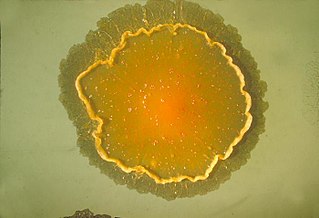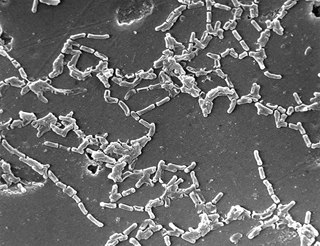Related Research Articles

Mycobacterium tuberculosis is a species of pathogenic bacteria in the family Mycobacteriaceae and the causative agent of tuberculosis. First discovered in 1882 by Robert Koch, M. tuberculosis has an unusual, waxy coating on its cell surface primarily due to the presence of mycolic acid. This coating makes the cells impervious to Gram staining, and as a result, M. tuberculosis can appear either Gram-negative or Gram-positive. Acid-fast stains such as Ziehl–Neelsen, or fluorescent stains such as auramine are used instead to identify M. tuberculosis with a microscope. The physiology of M. tuberculosis is highly aerobic and requires high levels of oxygen. Primarily a pathogen of the mammalian respiratory system, it infects the lungs. The most frequently used diagnostic methods for tuberculosis are the tuberculin skin test, acid-fast stain, culture, and polymerase chain reaction.

Mycobacterium is a genus of Actinobacteria, given its own family, the Mycobacteriaceae. Over 190 species are recognized in this genus. This genus includes pathogens known to cause serious diseases in mammals, including tuberculosis and leprosy in humans. The Greek prefix myco- means "fungus," alluding to the way mycobacteria have been observed to grow in a mold-like fashion on the surface of cultures. It is acid fast and cannot be stained by the Gram stain procedure.

Mycobacterium marinum is a slow growing mycobacterium (SGM) belonging to the genus Mycobacterium and the phylum Actinobacteria. The strain marinum was first identified by Aronson in 1926 and it is observed as a pathogenic mycobacterium. For example, tuberculosis like infections in fish (mycobacteriosis) and skin lesions in humans.

Mycobacterium abscessus complex (MABSC) is a group of rapidly growing, multidrug-resistant, nontuberculous mycobacteria (NTM) species that are common soil and water contaminants. Although M. abscessus complex most commonly causes chronic lung infection and skin and soft tissue infection (SSTI), the complex can also cause infection in almost all human organs, mostly in patients with suppressed immune systems. Amongst NTM species responsible for disease, infection caused by M. abscessus complex are more difficult to treat due to antimicrobial drug resistance.
Mycobacterium botniense is a slowly growing Mycobacterium, which produces a yellow pigment. It was first isolated from a stream of water. M. botniense is most closely related to Mycobacterium xenopi. Etymology: botniense; of Botnia, referring to the Latin name of the province of Finland from which the isolation was made.
Mycobacterium branderi is a slowly growing, nonchromogenic Mycobacterium first isolated from patients in Finland. Etymology: of Brander, referring to Eljas Brander, the former head of the Tuberculosis Laboratory of the National Public Health Institute, Finland, who collected the strains.

Mycobacterium chelonae is a species of the phylum Actinobacteria, belonging to the genus Mycobacterium. Mycobacterium chelonae is a rapidly growing mycobacterium, that is found all throughout the environment including sewage and tap water. It can occasionally cause opportunistic infections of humans.
Mycobacterium conceptionense is a non pigmented rapidly growing mycobacterium was first isolated from wound liquid outflow, bone tissue biopsy, and excised skin tissue from a 31-year-old woman who suffered an accidental open right tibia fracture and prolonged stay in a river. Etymology: conceptionense, pertaining to Hôpital de la Conception, the hospital where the first strain was isolated.

Mycobacterium cosmeticum is a rapidly growing mycobacterium that was first isolated from cosmetic patients and sites performing cosmetic procedures.
Mycobacterium elephantis, a bacterium of the family Mycobacteriaceae, was discovered and isolated from a deceased elephant near India and may be linked to respiratory dysfunction. Organisms in the genus Mycobacterium are known to be aerobic and non-motile. Organisms within Mycobacterium belong to either the rapid growing group or the slow growing group. M. elephantis is classified as a rapid grower and relates most closely to Mycobacterium confluentis and Mycobacterium phlei.
Mycobacterium gastri is a species of the phylum Actinobacteria, belonging to the genus Mycobacterium.
Mycobacterium goodii is an acid-fast bacterial species in the phylum Actinobacteria and the genus Mycobacterium.
Mycobacterium gordonae is a species of Mycobacterium named for Ruth E. Gordon. It is a species of the phylum actinobacteria, belonging to the genus Mycobacterium.
Mycobacterium kubicae is a Gram-positive, nonmotile and acid-fast bacterial species. Cells are typically rod-shaped, with some coccoid forms. Colonies of M. kubicae on solid media are generally smooth and domed, with a yellow scotochromogenic pigment. On Löwenstein-Jensen media they appear film-like. This species is not known to be pathogenic to humans. The species is named after American mycobacteriologist George Kubica.
Mycobacterium massiliense is a rapidly growing Mycobacteria species sharing an identical 16S rRNA sequence with Mycobacterium abscessus. Etymology: massiliense, pertaining to Massilia, the Latin name of Marseille, France where the organism was isolated.
Mycobacterium mucogenicum
Etymology: mucogenicum, from the organism's highly mucoid appearance.
Mycobacterium murale
Mycobacterium wolinskyi is a rapidly growing mycobacterium most commonly seen in post-traumatic wound infections, especially those following open fractures and with associated osteomyelitis. Mycobacterium wolinskyi is clearly clinically significant, and occurs in the same settings as Mycobacterium smegmatis and members of the Mycobacterium fortuitum complex; they differ from members of the Mycobacterium fortuitum complex in the type of chronic lung disease they produce, with essentially all cases occurring in the setting of chronic lipoid pneumonia, either secondary to chronic oil ingestion or chronic aspiration. Etymology: Wolinsky, named after Emanuel Wolinsky in honour of, and in recognition for, significant contributions to the study of the non-tuberculous mycobacteria.
Mycobacterium tusciae is a slow-growing, scotochromogenic mycobacterium first isolated from a lymph node of an immunocompromised child and subsequently from tap water and from a respiratory specimen of a patient with chronic fibrosis. Etymology: tusciae referring to the Italian region of Tuscany, where the organisms were first isolated.
Middlebrook 7H9 broth is a liquid growth medium specially used for culture of Mycobacterium species, notably Mycobacterium tuberculosis.
References
- 1 2 3 4 5 Fukano, Hanako; Wada, Shinpei; Kurata, Osamu; Katayama, Kinya; Fujiwara, Nagatoshi; Hoshino, Yoshihiko (1 August 2017). "Mycobacterium stephanolepidis sp. nov., a rapidly growing species related to Mycobacterium chelonae, isolated from marine teleost fish, Stephanolepis cirrhifer". International Journal of Systematic and Evolutionary Microbiology. 67 (8): 2811–2817. doi: 10.1099/ijsem.0.002028 . PMID 28857733.
- 1 2 Fukano, Hanako; Yoshida, Mitsunori; Katayama, Yukie; Omatsu, Tsutomu; Mizutani, Tetsuya; Kurata, Osamu; Wada, Shinpei; Hoshino, Yoshihiko (17 August 2017). "Complete Genome Sequence of". Genome Announcements. 5 (33). doi:10.1128/genomeA.00810-17. PMC 5604778 . PMID 28818905.